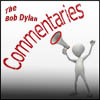Legend has it that Robert Johnson, the bluesman extraordinaire, sold his soul to the devil in exchange for an otherworldly Read more
from 11 Outlined Epitaphs (album liner notes) I end up thenin the early evenin'blindly punchin' at the blindbreathin' heavystutterin'an' blowin' Read more
Tim Riley, the author of Hard Rain, calls Dylan rock-n-roll's “Zelig”, a reference to the Woody Allen movie in which Read more
"The idea that poetry was spoken in the streets and spoken publicly, you couldn't help but be excited by that," Read more
"I'm afraid I poached Bob Dylan's Highway 61 Revisited out of curiosity and found myself well rewarded. Dylan's cawing, derisive Read more
"Nobody has ever captured the sound of 3 a.m. better than that album," is how [Al] Kooper sums up Blonde Read more
Commentary Woody Guthrie was Dylan's most significant early influence. Dylan has spoken freely about Guthrie's impact, once referring to himself Read more
Clinton Heylin, in his book Recording Sessions, writes that Nashville Skyline could have been an attempt to make John Wesley Read more
Ralph Gleason, the esteemed music writer from back in the day, gushed over New Morning when it came out. It Read more
So far I have followed the roadmap God has made for me a long time ago, and if I had Read more














Creative, born writer like all us air signs.
___123___Bob Dylan Commentaries___123___
You’re doing a great job! We havent’ had any news for a long – time, not since Drifter’s Escape. Please don’t stop.
site matches the purpose. thanks!
Informative site! I like how readers can add their own comments. hope you add more over time.